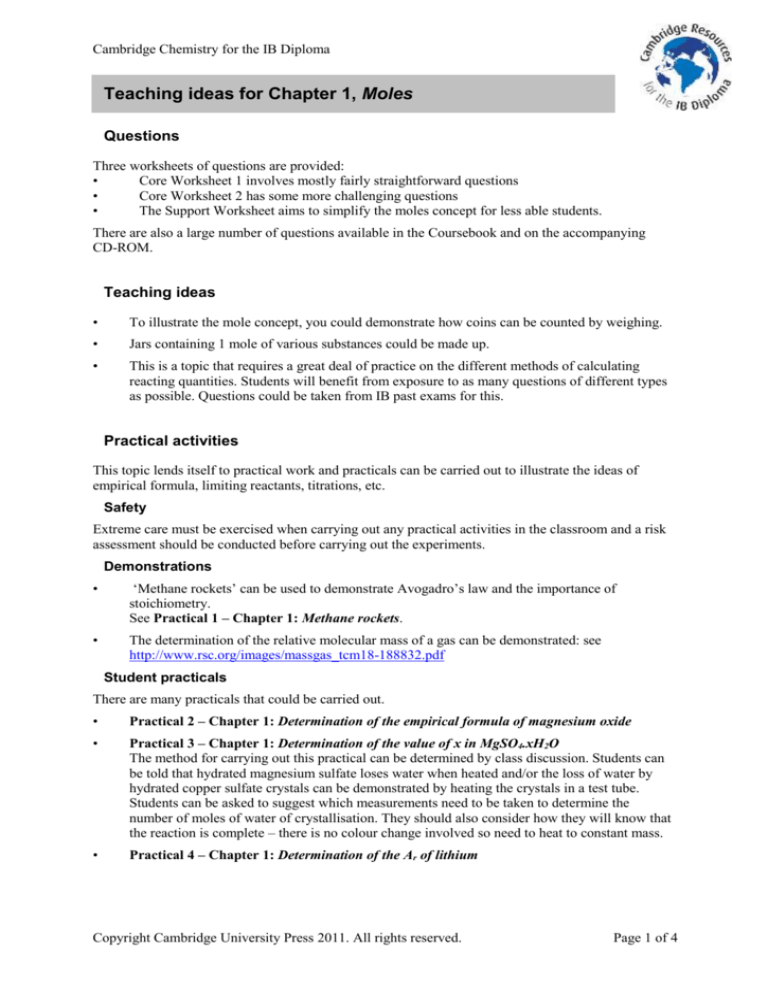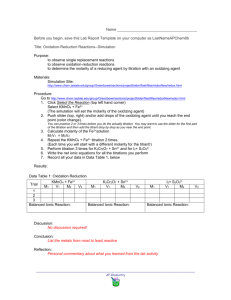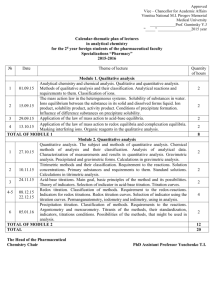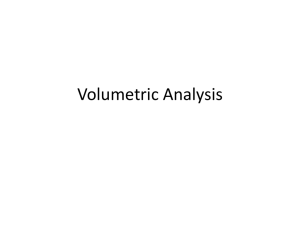
Cambridge Chemistry for the IB Diploma
Teaching ideas for Chapter 1, Moles
Questions
Three worksheets of questions are provided:
•
Core Worksheet 1 involves mostly fairly straightforward questions
•
Core Worksheet 2 has some more challenging questions
•
The Support Worksheet aims to simplify the moles concept for less able students.
There are also a large number of questions available in the Coursebook and on the accompanying
CD-ROM.
Teaching ideas
•
To illustrate the mole concept, you could demonstrate how coins can be counted by weighing.
•
Jars containing 1 mole of various substances could be made up.
•
This is a topic that requires a great deal of practice on the different methods of calculating
reacting quantities. Students will benefit from exposure to as many questions of different types
as possible. Questions could be taken from IB past exams for this.
Practical activities
This topic lends itself to practical work and practicals can be carried out to illustrate the ideas of
empirical formula, limiting reactants, titrations, etc.
Safety
Extreme care must be exercised when carrying out any practical activities in the classroom and a risk
assessment should be conducted before carrying out the experiments.
Demonstrations
•
‘Methane rockets’ can be used to demonstrate Avogadro’s law and the importance of
stoichiometry.
See Practical 1 – Chapter 1: Methane rockets.
•
The determination of the relative molecular mass of a gas can be demonstrated: see
http://www.rsc.org/images/massgas_tcm18-188832.pdf
Student practicals
There are many practicals that could be carried out.
•
Practical 2 – Chapter 1: Determination of the empirical formula of magnesium oxide
•
Practical 3 – Chapter 1: Determination of the value of x in MgSO4.xH2O
The method for carrying out this practical can be determined by class discussion. Students can
be told that hydrated magnesium sulfate loses water when heated and/or the loss of water by
hydrated copper sulfate crystals can be demonstrated by heating the crystals in a test tube.
Students can be asked to suggest which measurements need to be taken to determine the
number of moles of water of crystallisation. They should also consider how they will know that
the reaction is complete – there is no colour change involved so need to heat to constant mass.
•
Practical 4 – Chapter 1: Determination of the Ar of lithium
Copyright Cambridge University Press 2011. All rights reserved.
Page 1 of 4
Cambridge Chemistry for the IB Diploma
•
An acid–base titration
Examples of an acid–base titration could be a simple titration of 0.1 mol dm–3 sodium
hydroxide with approximately 0.1 mol dm–3 hydrochloric acid or a titration of white
wine with 0.1 mol dm–3 NaOH. The concept of a standard solution could also be
introduced/discussed.
•
Practical 5 – Chapter 1: Determination of vitamin C concentration in a solution
This is a more complicated practical but is a good exercise in following instructions. It will
allow students to gain experience of a different type of titration.
•
General details of how to carry out a titration may be found at
http://www.dartmouth.edu/~chemlab/techniques/titration.html
and in the volumetric analysis section of the interactive chemistry laboratory primer from the
Royal Society of Chemistry
http://chem-ilp.net/
This RSC website also contains videos and details of many other important chemical lab
techniques.
•
Worksheets for titrations and other practicals may be found at
http://www.creative-chemistry.org.uk/alevel/practical.htm
However, if you use these practicals for assessments then take care not to give too much
information, such as data tables, etc., to the students.
•
Other ideas for practical work can be found at
http://www.practicalchemistry.org/experiments/advanced/amount-of-substance/topicindex.html
•
The Avogadro constant can be determined using the following procedures:
http://www.lahc.edu/classes/chemistry/arias/Exp%203%20-%20Avogadro.pdf
http://spot.pcc.edu/~chandy/100F03/DeterminationofAvogadro'sNumber.pdf
http://www.chem13news.uwaterloo.ca/issues/339/may06_2006_page_14.pdf
http://omnis.if.ufrj.br/~moriconi/termo_fisest/avogadro.htm
•
A practical procedure involving limiting reactants can be found at:
http://www.chymist.com/plop%20plop%20fizz%20fizz.pdf
•
The following sites provide information about back titrations:
http://www.philadelphia.edu.jo/academics/adokka/uploads/Spr05455Wk2Lab.PDF
http://www.toledotechnologyacademy.org/Documents/Chem%20Docs/ChemLab%20153%20Eggshell%20Titration.pdf
•
Redox titrations (also considered in the Teaching Ideas for Chapter 9):
http://homepage.smc.edu/kline_peggy/Chem_12/Labs/iron_titration.pdf
http://www.a-levelchemistry.co.uk/AQA%20A2%20Chemistry/Unit%206/PSA%20(PSV)/AQ
A-2420-W-TRB-PSA10.pdf
http://usm.maine.edu/~tracy/chy116sumfolder/chy116s2011labsfolder/RdxTi.html
http://infohost.nmt.edu/~jaltig/Bleach.pdf
http://www.ipfw.edu/chem/321/iodometric%20Cu%20determination.PDF
http://mhchem.org/222/pdfLabs222/CopperTitrations.pdf
http://www.csudh.edu/oliver/che230/labmanual/copbrass.htm
•
Practical 6 – Chapter 1: Synthesis of alum, KAl(SO4)2.12H2O
This practical can be used to investigate percentage yield. Alum is prepared from aluminium.
The following websites also deal with this reaction:
http://wwwchem.csustan.edu/archive/alum.htm
http://www.ic.sunysb.edu/Class/che133/susb/susb030.pdf
Copyright Cambridge University Press 2011. All rights reserved.
Page 2 of 4
Cambridge Chemistry for the IB Diploma
Common problems
•
Students find this topic quite difficult and different approaches may have to be used
with different students. Some students like the security of equations that can be used in all
circumstances whereas others benefit from working things out from first principles.
•
Many students have difficulty with number of particles and converting to and from moles.
Problems such as ‘how many hydrogen atoms are present in 0.10 mol CH3COOH’ often cause
difficulties.
•
Students can also get mixed up as to whether they are considering moles of atoms, molecules or
ions.
•
The ideas of limiting reactants can cause problems. Students can be advised that, to solve a
moles problem, they only need enough information to work out the number of moles of one
substance. If enough information is given to work out the number of moles of more than one
substance then there is a high probability that one of these is a limiting reactant and that the
others will be in excess.
•
Support Worksheet – Chapter 1: Voles is a support question sheet that could be useful for
weaker students.
ICT
•
Students can use spreadsheets to process data from practical work.
Simulations
•
Application 1 on the Coursebook CD-ROM can be used to calculate relative molecular masses
and masses of single molecules.
•
Number of particles/mass of a molecule:
http://www.chem.iastate.edu/group/Greenbowe/sections/projectfolder/flashfiles/stoichiometry/s
olid_atoms.html
•
Empirical and molecular formula:
http://www.chem.iastate.edu/group/Greenbowe/sections/projectfolder/flashfiles/stoichiometry/
empirical.html
•
Limiting reactants:
http://www.chm.davidson.edu/ronutt/che115/Simult/Simult.htm
http://phet.colorado.edu/en/simulation/reactants-products-and-leftovers
http://www.chemcollective.org/assignments.php#stoichiometry
•
Gas laws:
http://www.chem.iastate.edu/group/Greenbowe/sections/projectfolder/flashfiles/gaslaw/boyles_
law_graph.html
http://www.chem.iastate.edu/group/Greenbowe/sections/projectfolder/flashfiles/gaslaw/charles
_law.html
•
Titrations:
http://www.chem.iastate.edu/group/Greenbowe/sections/projectfolder/flashfiles/stoichiometry/
acid_base.html
http://www.mhhe.com/physsci/chemistry/animations/chang_7e_esp/crm3s5_5.swf
http://lrs.ed.uiuc.edu/students/mihyewon/chemlab_experiment.html
http://www.blackgold.ab.ca/ict/Division4/Science/Div.%204/Titration%20of%20Vinegar/vineg
artitration.htm
Copyright Cambridge University Press 2011. All rights reserved.
Page 3 of 4
Cambridge Chemistry for the IB Diploma
Theory of knowledge (TOK)
Chemistry deals with enormous differences in scale. The magnitude of Avogadro’s constant is
beyond the scale of our everyday experience. Students could discuss how we attempt to ‘understand’
a number like this by reference to things with which we are more familiar.
The distinction between the Celsius and Kelvin scales as examples of an artificial and natural scale
could be discussed. If Practical 4 – Chapter 1: Determination of the Ar of lithium is carried out, it
could be discussed why the percentage uncertainty on a temperature in C is meaningless.
Ideal and real gases could be discussed. Why do chemists use the concept of an ideal gas when it is
‘not correct’?
Copyright Cambridge University Press 2011. All rights reserved.
Page 4 of 4









